
Carl Christian Wivel (12 October 1844 - 10 March 1922) was a Danish restaurateur who was best known for establishing the entertainment venue Restaurant Wivel (later continued as Wiwex) in Tivoli Gardens.

Carl Christian Wivel (12 October 1844 - 10 March 1922) was a Danish restaurateur who was best known for establishing the entertainment venue Restaurant Wivel (later continued as Wiwex) in Tivoli Gardens.
Wivel was born on 12 October 1844 in Copenhagen, the son of joiner Jens Christian Wivel (1802–60) and Lovise Emilie Alvsen (1811–58). He served as a volunteer in the First Schleswig War. He was later trained as a barber before establishing his own barber shop on Holmens Kanal in 1872. [1] He was later trained as a barber and established his own barber shop on Holmens Kanal in 1872.
In 1880, he took over the restaurant Røde Lygte on Gothersgade. In 1883, he aæsp leased the newly built Tårnpavillon (Tower Pavilion) in Tiboli Gardens. He kept Røde Lygte until 1888. In 1884, he successfully hosted a banquest for theInternational Medical Convention in Tivoli Gardens. The guests included Louis Pasteur. The Nordic Exhibition of 1888 contributed to further expanding his business. [1]

In 1890, he opened Restaurant Wivel next to Tivoli Gardens' main entrance on Vesterbrogade. It was later expanded woth more rooms until it continued all the way to the corner and down Bernstorffsgade. In 1910, Wivel took his nephew Anton Ludvig Pedersen (1868–1929) as a partner. In 1916, he retired from the company. [1]
Wivel was also involved in construction projects. He constructed and owned Højbrohus at the corner of Østergade and Amagertorv in Copenhagen. He was chairman of the Copenhagen chapter of the Association of Restaurateurs and Hoteliers. and vice chairman of the Copenhagen chapter of the De Danske Vaabenbrødre society. [2]
On 8 November 1878, Wivel married to Ulrikke Sarine (Serine) Cathrine Meyer (1854–1927). She was a daughter of café-owner Johan Martin Theodor Meyer (ca. 1825–77) and Mette Cathrine Petersen (ca. 1824–64). [1] The couple were the parents of the daughter Anny Emilie Wivel (1879–1945). She was married to Jean Francois Davin Rosenstand (1867–1942).
In 1905, Wivel was awarded the title of kammerråd. In 1909, he was created a Knight of the Order of the Dannebrog. In 1919, he was awarded the Cross of Honour.
He died on 10 March 1922 in Monte Carlo. He is buried in a mausoleum at Frederiksberg Old Cemetery. [3]
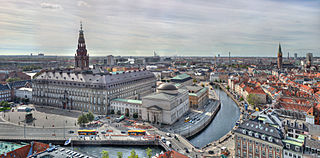
Copenhagen is the capital and most populous city of Denmark, with a population of approximately 660,000 in the municipality and 1.4 million in the urban area. The city is situated on the islands of Zealand and Amager, separated from Malmö, Sweden, by the Øresund strait. The Øresund Bridge connects the two cities by rail and road.

Tivoli Gardens, also known simply as Tivoli, is an amusement park and pleasure garden in Copenhagen, Denmark. The park opened on 15 August 1843 and is the third-oldest operating amusement park in the world, after Dyrehavsbakken in nearby Klampenborg, also in Denmark, and Wurstelprater in Vienna, Austria.

Christianshavn is a neighbourhood in Copenhagen, Denmark. Part of the Indre By District, it is located on several artificial islands between the islands of Zealand and Amager and separated from the rest of the city centre by the Inner Harbour. It was founded in the early 17th century by Christian IV as part of his extension of the fortifications of Copenhagen. Originally, it was laid out as an independent privileged merchant's town with inspiration from Dutch cities but it was soon incorporated into Copenhagen proper. Dominated by canals, it is the part of Copenhagen with the most nautical atmosphere.

The Holmen Church is a Parish church in central Copenhagen in Denmark, on the street called Holmens Kanal. First built as an anchor forge in 1563, it was converted into a naval church by Christian IV. It is famous for having hosted the wedding between Margrethe II of Denmark, queen of Denmark between 1972 and 2024, and Prince Henrik in 1967. It is the burial site of such notabilities as naval heroes Niels Juel and Peter Tordenskjold, and composer Niels Wilhelm Gade, and contains artwork by, among others, Bertel Thorvaldsen and Karel van Mander.

Frederiksberg is a part of the Capital Region of Denmark. It is formally an independent municipality, Frederiksberg Municipality, separate from Copenhagen Municipality, but both are a part of the City of Copenhagen. It occupies an area of less than 9 km2 and had a population of 103,192 in 2015.
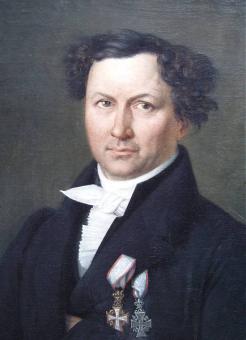
Jørgen Hansen Koch was a Neoclassical Danish architect. He was chief of the national Danish building administration from 1835 and director of the Royal Danish Academy of Fine Arts from 1844 to 1849.

Johannes Emil Gnudtzmann was a Danish architect working in the Historicist style. His most notable works are St. Paul's Church and the extension of the Royal Veterinary and Agricultural University's main building, both in Copenhagen. He was the father of Kaj Gnudtzmann.
Events from the year 1844 in Denmark.
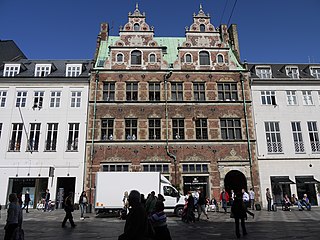
The Matthias Hansen House, formerly also known as the Schoustrup House, is a Renaissance-style townhouse on Amagertorv in central Copenhagen, Denmark. Built in 1616, it is one of few buildings of its kind which has survived the Copenhagen Fires of 1728 and 1795. The building is now home to a flagship store for the Royal Copenhagen porcelain factory.

Stormgade is a street in central Copenhagen, Denmark. It runs from Frederiksholm Canal to H. C. Andersens Boulevard where it turns into Tietgensgade before continuing along the rear side of Tivoli Gardens and Copenhagen Central Station. In the opposite direction, Storm Bridge connects it to Slotsholmen where traffic may continue across Holmen's Bridge to Holmens Kanal, part of Ring 2, or across Knippel's Bridge to Christianshavn and Amager. The name of the street refers to the Swedish Storm of Copenhagen in 1659.

Aage Langeland-Mathiesen was a Danish architect. He was active both in building design and restoration, and was associated with the National Museum for many years. His building designs are strongly influenced by his interest in historic architecture. He collaborated with his more well-known colleague Ulrik Plesner on many projects.
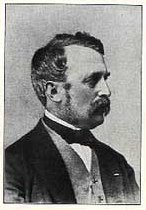
Harald Conrad Stilling was a Danish architect who was active in Copenhagen during the Late Classical period of the mid-18th century. He received the C. F. Hansen Medal in 1841.

Peter Nicolaj Arbo was a Norwegian-Danish timber trader and landowner. He owned the estates Aldershvile, Lundbygård and Oremandsgaard in Denmark and Gulskogen Manor in Norway.
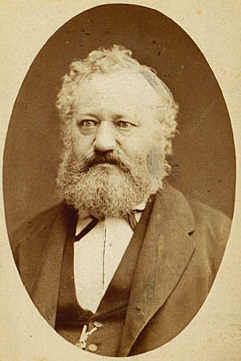
Lauritz Godtfred Rasmussen was a Danish zinc and bronze caster. He established a zinc and bronze foundry in his own name in Copenhagen in 1865 and was appointed royal court caster in 1883. Many Danish monuments from the second half of the 19th century come from his foundry. It was later taken over by his son Carl Rasmussen and remained in the family for several generations.
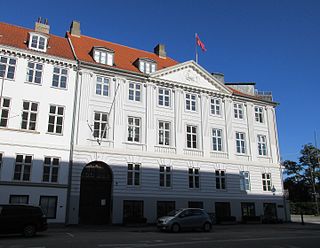
Amaliegade 40, formerly known as Toldbodbørsen, is a Neoclassical property located at the corner of Amaliegade and Esplanaden in the Frederiksstaden district of Copenhagen, Denmark. The shipping company D/S Norden was based in the building for more than one hundred years. It was listed in the Danish registry of protected buildings and places in 1918.
Lars Larsen was a Danish merchant, ship-owner and shipbuilder. The Lars Larsen House, his former home in Copenhagen, was listed on the Danish registry of protected buildings and places in 1918. He has also lent his name to Larsens Plads, a former dockyard located adjacent to Amalienborg Palace.

Rogert Møller was a Danish architect and credit union manager. He was as an architect mainly active in the Vesterbro district of Copenhagen, designing many residential buildings during the population boom of the late 19th century. He worked for Østifternes Kreditforening from 1876 and served as chief technical officer from 1904.

Gammel Strand 40 is a Neoclassical property overlooking Slotsholmen Canal in the Olt Town of Copenhagen, Denmark. The building was listed in the Danish registry of protected buildings and places in 1945. A commemorative plaque above the doorway commemorates that Georg Carstensen, founder of Tivoli Gardens, was a resident in the building when his amusement park opened in 1843. Other notable former residents of Gammel Strand 40 include the archeologist Peter Oluf Brøndsted, writer and editor Jacob Davidsen (1813–1891), songwriter Peter Faber, politician and bishop Ditlev Gothard Monra and journalist Henrik Cacling.d

Ny Adelgade 9/Grønnegade 32 is a Neoclassical building situated at the corner of Ny Adelgade and Grønnegade in the Old Town of Copenhagen, Denmark. The building was listed in the Danish registry of protected buildings and places in 1982.
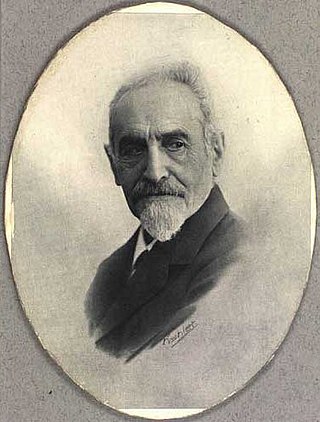
Frederik Lauritz Levy was a Danish architect.